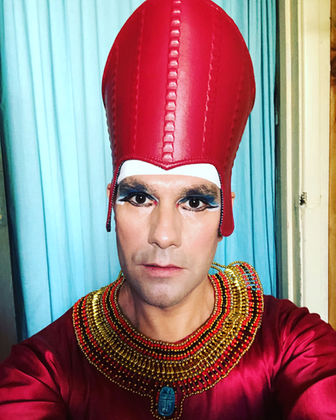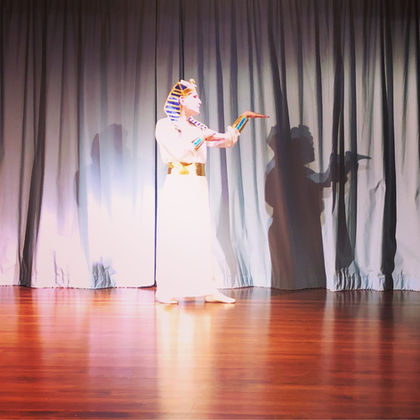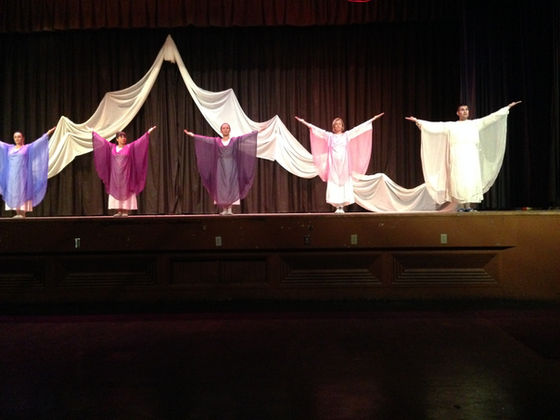
"I spent long days and nights in the studio seeking that dance which might be the divine expression of the human spirit through the medium of the body's movement. For hours I would stand quite still my two hands folded between my breasts, covering the solar plexus...
I was seeking and finally discovered the central spring of all movements, the crater of motor power, the unity from which all diversities of movements are born, the mirror of vision for the creation of the dance-it was from this discovery that was born the theory on which I founded my school...
I, on the contrary, sought the source of the spiritual expression to flow into the channels of the body filling it with vibrating light-the centrifugal force reflecting the spirit`s vision. After many months, when I had learned to concentrate all my force to this one Center I found thereafter when I listened to music the rays and vibrations of the music streamed to this one fount of light within me - there they reflected themselves in Spiritual Vision not the brains mirror but the soul`s, and from this vision, I could express them in Dance."
Taken from Isadora Duncan: "The Art of the Dance"
The word Eurythmy comes from Old Greek language "Euryhtmia". "Eu"-meaning well, good,"Rythmos"-meaning harmonious, rhythmical order, well proportioned.
Compared with other artistic dance forms, Eurythmy is still a very young art of expressive movement/dance. Rudolf Steiner was very particular in creating this new art, and he did not like to compare it with other dance forms or even use the word "dance" to describe Eurythmy. Much of what is written about it is for people who are Eurythmists, and who have studied or are studying Rudolf Steiner`s philosophy, Waldorf Education, and others of his works. But not so much is written for someone who has never heard about Eurythmy. It is a form of art that has to be shown and taught live, experienced in person. We live in a world where we are surrounded by materialistic goods and high technology. We become somewhat stuck on particular names of objects with which we are familiar. In that regard I use the word "dance" purposely to make it somewhat more clear for my website readers when they come across this art form called Eurythmy.
Eurythmy stands between classical dance (ballet) and modern dance forms. In dance and any form of movement the center of gravity is in the hips. We related to the earth through the hips. In Eurythmy the center of gravity is elevated in the heart space. Eurythmy expresses through music and spoken word (story telling, poetry, etc). The performer`s body enhances the experiences what is happening with the music and spoken word live on stage. This art of dance sculpts the space around the moving human being. A lot of gestures of daily life, colors, moods, and emotions are reflected and transformed into the movements of Eurythmy.
Using art this dance form works on cognitive thinking, space awareness in our human body as well the space we surround ourselves every day, teaches us how to move together in a group, as a group, very strong social aspect and space, stage awareness. Awakens and works with awareness of the whole human body: movement directions in space such as: left right, up and down, forwards-backwards, fast and slow.
“...In a conversation with Rudolf Steiner, one of his students, Mrs. Clara Smits, mentioned that her daughter had expressed the wish to take up, professionally, some form of rhythmic gymnastics or dancing. This conversation took place in 1911 in Berlin, Germany, and had far-reaching consequences. It was, in fact, the starting point of this new art of movement, based on spiritual science. The daughter, Lory Smits, later became the first eurythmist…”
Eurythmy Essays and Anecdotes In Art, Education, and Therapy, Schaumburg Publications, Inc.
Take from them what speaks to you:
“ … Eurythmy can be accompanied, not only by recitation and declamation, but also by instrumental music. But here it must always be borne in mind that Eurythmy is music translated into movement, and is not dancing in any sense of the word. There is a fundamental difference between Eurythmy and dancing. People, however, often fail to make this distinction when seeing Eurythmy on the stage, owing to the fact that Eurythmy uses as its instrument the human body in motion. “
Rudolf Steiner, 26 August 1923
“… What we know under the name of Eurythmy is nothing else than the means whereby the human organism can find healthy outlet through movement. So that certain of the movements of Eurythmy, though naturally differing somewhat from the movements which we use in Eurythmy as an art, and having undergone a certain metamorphosis, can be made use of and developed into a Curative Eurythmy. This Curative Eurythmy can be of extreme value in the treatment of illness, and can be applied in certain cases where one knows the way in which certain movements will react upon a certain organ with beneficial results.”
Rudolf Steiner, 26 August 1923
Eurythmy has three branches: Pedagogical, taught at Waldorf Schools worldwide;
Curative, therapeutic, healing;
Artistic, performing.
It is very unique form of movement art.
As an artist, I am working with the artistic Eurythmy aspect at the present time. I am constantly working on new projects in Los Angeles and in Southern California.
Please feel free to contact me for more information about this unique art form and any upcoming projects, workshops and performances.
























